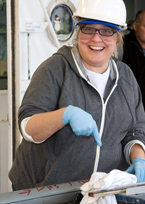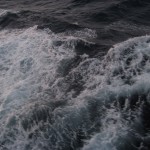Teacher at Sea
March 26, 2011

Julie Pollard, a 7th and 8th grade science teacher from Watauga, Texas used a video-enabled laptop to take students on virtual tours of the ship. At one stop, a micropaleontologist was explaining how she and her colleagues were sampling cores to find nannofossils and she told the kids how many could fit across one human hair.
“I was watching the kids and nearly every one of them yanked a hair out of their head and looked at it,” she says. “I knew they were connecting with what she was saying.”
Pollard sailed on board the JOIDES Resolution as the Onboard Education Officer for Expedition 317. She learned shipboard science alongside the expedition’s science party and translated her learning experiences for students and the general public through a blog and live video conferences. She connected directly with students in Nebraska, California, Texas and France.
“Maybe now some of them might consider a career in science when they might not have before,” she says.
Before the trip, her students tended to think of scientists as people in white coats working in a lab with test tubes.
“They saw scientists in shorts and flip flops listening to their iPods traveling the world on a ship,” she says. “It busted stereotypes. They realized you could do cool science and get paid to travel the world.”
Working the night shift so that she could connect with students around the world during class time, her meal schedule was a bit out of whack. Her first meal of the day, at midnight, might be spaghetti. Her second meal, at 6:00 a.m., might be eggs and bacon or cereal and fruit. She said it was a bit like the movie Groundhog Day.

“I seem to have lost that distinct feeling of one day ending and another one beginning,” she wrote in her blog. “When I wake up to start my shift, it doesn’t feel like “morning” – it’s just time to get to work. ? It’s almost like one long day punctuated by naps.”
She also wrote about an otherworldly sight from the bow of the ship one pitch black night.
“Looking down into the wake generated by the ship, there were tons of bioluminescent algae just twinkling and sparkling,” she wrote. “They looked like Christmas lights blinking under the water. Tim said they’re churned up by the motion of the ship, and that we will often see them in cooler waters (we are headed farther away from the equator). I stood out there and watched for a long time, and when I looked up, the clouds had cleared and the sky was full of stars. Stars above, stars below. It was an amazing sight.”
by Marc Airhart
>>> Return to “Down to the Core”
Also See:
Julie Pollard’s Blog
For more information about the Jackson School contact J.B. Bird at jbird@jsg.utexas.edu, 512-232-9623.
